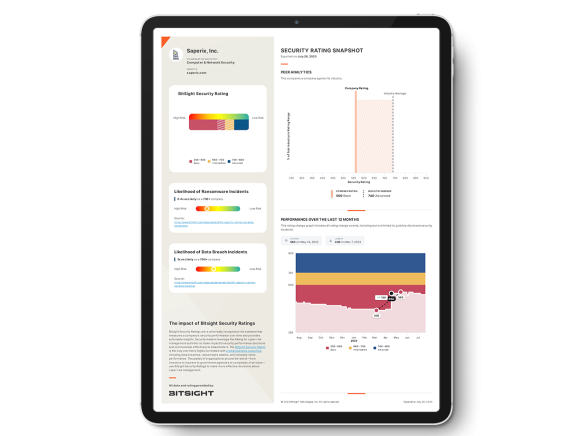New! The Security Ratings report is now the Executive Report. Request your report to see enhanced analysis such as your rating, likelihood of ransomware incidents, and likelihood of data breach incidents.

As security and risk professionals work to finish out the year, they must also be thoughtful about planning for 2018. While it’s great to end the last quarter of the business year on a strong note, it’s even more critical for businesses to set themselves up for success when returning to work in January. One of the best ways to accomplish this is to be strategic about the extra budget they possess in Q4, and asking themselves this question: how can my organization be mindful about spending extra funds to benefit our security program later on?
Security and risk professionals must identify, quantify and mitigate risk across their organization and ecosystem. A primary way to do this is with security ratings, which support their security program and their vendor risk program. So why are security ratings so central to a strong security and risk management program? Here are four reasons:
- Security ratings help concretely demonstrate performance from a security perspective. As businesses move into 2018, an increasing demand will be placed on security and risk teams to effectively demonstrate how their performance. They may be required to report to the Board of Directors about internal and vendor risk, demonstrate their success, and justify budget by demonstrating return on investment. The easiest way to speak to each of these points is by presenting an easily consumable, quantifiable metric that allows executives to easily understand the security posture of their organization.
- Security and risk professionals must be able to provide actionable metrics to facilitate internal discussions with their organization’s decision-makers, but they will also be able to use security ratings to demonstrate how their suppliers and third parties are impacting their security posture. With the increase of data breaches made possible through a third party, third-party risk management (or vendor risk management) should be on every organization’s mind heading into the new year.
- Security ratings can also help organizations collaborate more closely with vendors to proactively mitigate the risk that they present. In today’s business landscape, it’s critical to manage the risk that your vendors, or third parties, can pose to your business — and it’s not always the easiest task. It requires that organizations not only have the ability to continuously monitor and identify new risk, but also the ability to work with their vendors to fix security issues quickly. Getting to risk reduction rapidly means that both organizations are communicating effectively, using data and evidence rather than conjecture to make progress. By understanding the scope of your vendor ecosystem (how many vendors your organization does business with, and what information they have access to), you can better shape your vendor risk management program and strategy.
- Security ratings help your organization scale as your vendor ecosystem (and the risk it presents) continues to grow. As your business continues to grow and outsource, security ratings help to ensure that you are able to scale your vendor risk management programs to effectively measure and remediate risk across all third parties. By using security ratings to continuously monitor the security posture of their vendors, organizations can be notified if there is a significant change in any vendor’s security posture and adjust their business practices accordingly if necessary.
By choosing to invest extra budget in a security ratings solution, organizations are taking a proactive approach in the future of their organization. Security ratings allow businesses to quantify risk and drive internal discussions about their security posture, and ultimately, their vulnerability to attack.
How secure is your organization?
